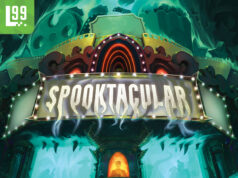Note: This preview uses pre-release components and rules. What you see here may be different from the final, published game.
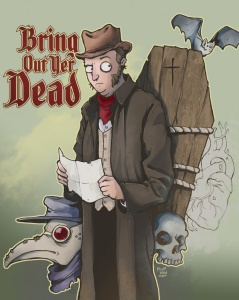 When my gaming group gets together for our Dungeons & Dragons nights, we have a few requirements. My wife makes an awesome dessert, someone brings cold beer, and we make as many old movie references that we can fit into the limited time we have to play. One of the movies we quote with some frequency is Monty Python and the Holy Grail. One of the scenes is set in an filth-ridden town where people are throwing their deceased family member into a cart. If you have ever wanted to do that in a board game, you are in luck, because Bring Out Yer Dead allows you to do exactly that.
When my gaming group gets together for our Dungeons & Dragons nights, we have a few requirements. My wife makes an awesome dessert, someone brings cold beer, and we make as many old movie references that we can fit into the limited time we have to play. One of the movies we quote with some frequency is Monty Python and the Holy Grail. One of the scenes is set in an filth-ridden town where people are throwing their deceased family member into a cart. If you have ever wanted to do that in a board game, you are in luck, because Bring Out Yer Dead allows you to do exactly that.
Bring Out Yer Dead is action programming and area control game looking for funding on Kickstarter. In Bring Out Yer Dead, you are trying to place your dead relatives into the best spots in the cemetery for your own gain. The theme is one of the more interesting and frankly morbid I have played recently, but let’s get into the preview to see if you would like to support this solidly designed game.
Game Overview:
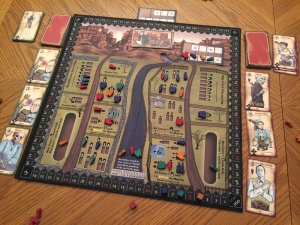
The head of your family has died. The will has been read and you are last in line to take over the family. This doesn’t sit well with you. You have decided to take matters into your own hands and improve your position. The dirty work has been done, but now you need to get your family members into the most exclusive cemetery in the city. You thought this would be the easy part, but two things came up that you didn’t expect. One, that there people would be making the same power move in their families causing more competition in the cemetery and the laziness of the Gravedigger. Each day he only has a limited number of spots in his cart and for each one over his limit, he will toss them into the river. Players will have to bid effectively to get their coffins not only buried, but also in the best spots. You might even be forced to do some grave robbing and grave swapping to earn the points necessary to win the game. After eight rounds of play or when one player has placed all of their coffin tokens on the board, you will total up victory points and the player with the most wins the game.
How to Play:
Everyone starts that game with a set of double and single coffin tokens and a set of seven cards. Each of the cards has a numerical value and the higher the value, the earlier it is resolved when played. Five of these cards are player cards that remain in a player’s hand the entire game. Three of these allow the placing tokens on the grave cart with the other two being only powerful if played together to allow you to draw a Fate card.
Fate cards allow for you to manipulate things in the game like switching grave sites, pulling coffins out of the river and claiming a spot on the card. The other type of card in the game is the Treasure card. Treasure cards allow players to earn victory points during the game if they are played or at the end depending on the card type. Both Fate and Treasure cards are discarded once they are played. Let’s move to how the game plays.
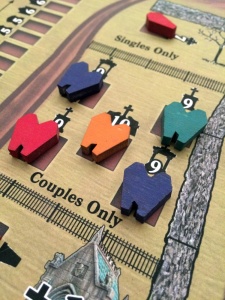
1. Reveal the Undertaker card and choose his path
The Undertaker cards reveal how many spots the grave cart has for this turn. The eight cards in the game vary in the number of spots available. On the game board, the cemetery is separated into two sides by the river. The first player that turn decides which side of the cemetery the coffins in the cart will be buried this round.
2. Bidding
Players are required to place three cards face down on the table. Players may play any card from their hand, but cannot place two cards with the same value.
3. Reveal and Resolve cards
After all bids are placed, players will flip over their three cards. All cards are resolved in order of rank, with ties being broken by starting with the first player and continuing in clockwise order. Depending on which cards are played, a player may add coffins to the cart, manipulate coffins locations, or earn victory points.
4. Place coffin tokens
Players remove tokens from the Undertaker card in the order that they were placed and put them in grave sites on the side of the river chosen by the first player. The cemetery plots all have victory points that players will earn at the end of the game. The cemetery is also separated into different locations that all have unique attributes. Some give extra or negative points for the majority, can only be couple coffin tokens, placed in a certain order or even a mass grave site that allows you to draw a Fate or Treasure card.
5. Clean-Up
The Undertaker card is discarded and the person who is to the left of the first player starts the round over again.
This will continue for eight rounds or until a player has successfully buried all of their coffins. Players will total up the points earned from the tokens on the board, negative points for each one in the river, and any victory points from Treasure cards that they still have in their hand. The player with the most victory points is the winner.
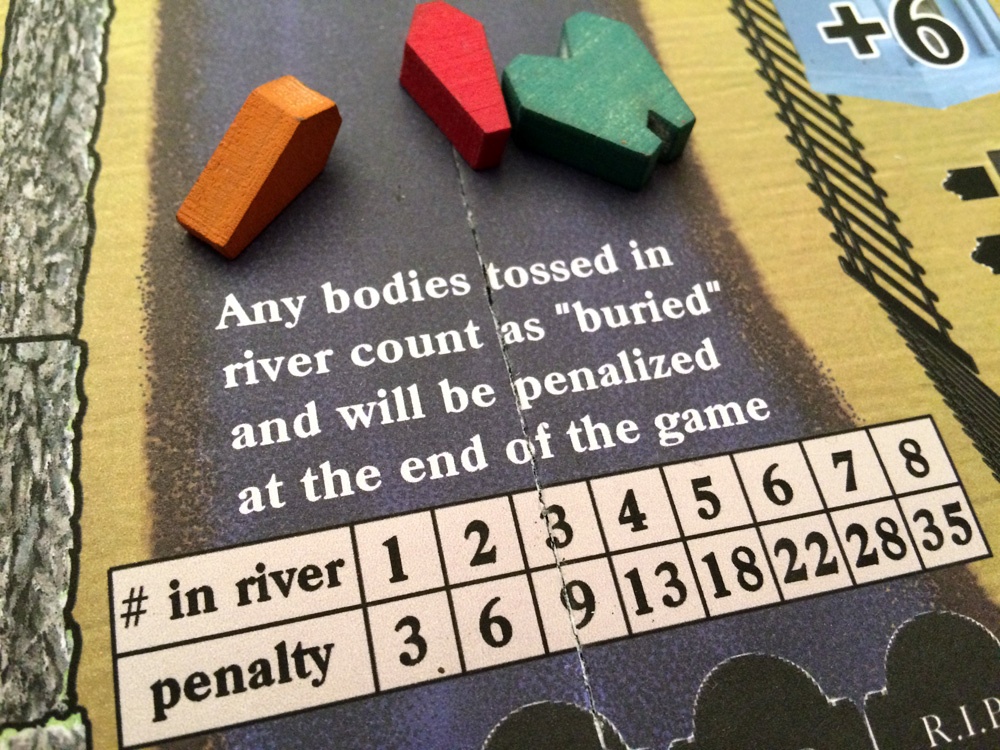
Game Experience:
I want to deal with something right off the bat, the theme. When I first read through the rulebook, I knew that this game might rub people the wrong way. The idea of murdering family members and then the possibility of having that person end up the river is just a very odd theme in a board game. Personally, I find I have no issue with the theme at all. First, the real dirty work of offing family members is already done for you. This removes the uncomfortable thought of having to plan how to remove family members from the land of the living. The art design in the game also makes this game less morbid for me. There are cards with decaying bodies or other odd things, but they are done in a cartoon style rather than being realistic. Using a light-hearted art style allows the game to be much more approachable. I have a feeling that people will just read the description and turn away. That is unfortunate because the game mechanics fit together to create a very well designed game.
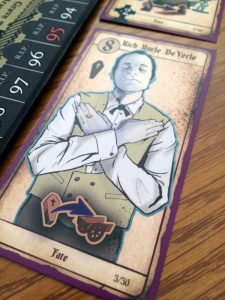
While playing the game, I was surprised with the amount of enjoyment by myself and the other players. When I explained it to them, there was a mix of shock and laughter. While learning the rules, I was worried that the game would be complicated. There was a lot going on with the different iconography on the cards and numerous spots on the board that it could be overwhelming, but it wasn’t. The game is pretty easy to learn. The overall game play only has three major phases to go through, moves very quickly and you can easily complete a game in less than forty-five minutes. There is a learning curve while players are understanding the iconography on the cards, but once that hurdle is overcome the game moves quickly.
I like the limited space mechanic on the Undertaker cards. This forces players to attempt to read the other players before they play their cards, because if don’t, you will lose too many coffin tokens to the river. This deduction happens because everyone has, at minimum, the same five cards in their hand. They might have a Fate card that does some manipulation, but without having these base cards, you couldn’t make any guesses about other player’s actions. This leads to a lot of player interaction in the game not only in the resolving of actions, but also the limited spaces on the board. I do like how the cemetery is separated into two distinct areas. This not only adds a layer of strategy for the player, but allows for each area to be unique. Each side having distinctive plot areas gives players something else to think about as they place their bids. Being aggressive with a Fate card could net you the last, or the last couple only spot, and force your opponents to change their strategy.
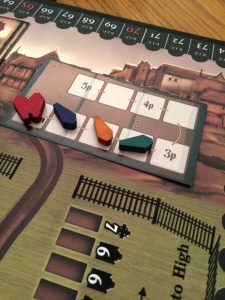
The order that ties are broken plays a major part in the game from a strategic perspective. If you are one of the last in line, you have to play conservatively. Otherwise you could easily end up with a coffin token or two in the river if you are not careful. Instead, this is the time to play Treasure or Fate cards to manipulate the composition of the board or earn some easy victory points. The Treasure and Fate cards make the game much more interesting. Most of the Fate cards are of high value and will activate before the others. This allows you to have the best opportunity to change how the game is going before anyone else has a turn. The Treasure cards give you the chance to remove them from your hand and earn some victory points while giving the player a ton of options on what to do when they bid.
Final Thoughts:
Games are all about taking a theme, melding it with mechanics and seeing if you get something fun at the end. I never thought I could have so much fun fighting over cemetery spots as I have with Bring Out Yer Dead. Despite the morbid theme, I do enjoy the mechanics, the actions planning, and area control elements of the game. Having the set of player cards that you always have at your disposal is interesting. You always know at least some of what your opponents have in their hand and can make a guess on what they might play during their turn. The Fate cards add necessary game altering events during the game and I like the powers that they possess. In contrast, the Treasure cards add extra victory points that can turn the game in your favor. The mix of player cards, Fate and Treasure cards create an interactive experience as you are playing against your opponents. If you are looking for a game to add to your collection consider backing Bring Out Yer Dead on Kickstarter.
If you’d like to become a backer, pledges start at $45 for the full game and all stretch goals. Bring Out Yer Dead is scheduled to be in backers hands in August of 2015 and you have until Wednesday, November 26th to become a backer. So head over today and check it out.
As always, we don’t post ratings for preview copies as the components and rules may change from the final game. Check back with us after the game is produced for a full review









